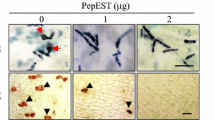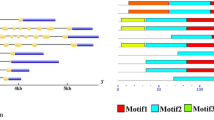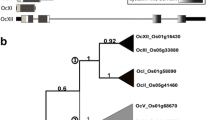Abstract
Carboxylesterases (CXEs) catalyze the hydrolysis of carboxylic acid esters into the corresponding acids and alcohols. Previously, a carboxylesterase gene was isolated from pepper (Capsicum annuum L.) and designated as PepEST. This gene is highly expressed during the incompatible interaction between ripe fruits of pepper and an anthracnose fungus (Colletotrichum gloeosporioides), and the PepEST protein exhibits an antifungal activity by suppressing fungal growth with the inhibition of appressorium formation. In this study, a PepEST-homologous gene was newly isolated from the pepper genome, which is designated as PepEST2 (the original PepEST gene is re-named here as PepEST1). Compared with PepEST1 whose expression is only induced by inoculation of the fungus, PepEST2 is not induced by fungus infection, rather expressed mainly in roots. Subcellular localization analysis using tobacco protoplasts showed that both PepEST1 and PepEST2 proteins are localized in the cytoplasm, and enzymatic activity assays showed similar Vmax and Km values of PepEST2 to those of PepEST1. Antifungal activity assays against C. gloeosporioides demonstrated that not only PepEST1 but also PepEST2 was able to suppress the fungal growth by inhibiting the appressorium formation. In addition, the antifungal activity of PepEST2 was higher than that of PepEST1. Collectively, this study suggests that two closely related members of pepper CXEs are functionally diversified due to the differential expression patterns, and also provides PepEST2 as an alternative gene to confer disease resistance to plants.





Similar content being viewed by others
Data availability
Data are available upon request.
References
Aranda J, Cerqueira NM, Fernandes PA, Roca M, Tunon I, Ramos MJ (2014) The catalytic mechanism of carboxylesterases: a computational study. Biochemistry 53:5820–5829
Baba VY, Powell AF, Ivamoto-Suzuki ST, Pereira LFP, Vanzela ALL, Giacomin RM, Strickler SR, Mueller LA, Rodrigues R, Goncalves LSA (2020) Capsidiol-related genes are highly expressed in response to Colletotrichum scovillei during Capsicum annuum fruit development stages. Sci Rep 10:12048
Cao X, Duan W, Wei C, Chen K, Grierson D, Zhang B (2019) Genome-wide identification and functional analysis of carboxylesterase and methylesterase gene families in peach (Prunus persica L. Batsch). Front Plant Sci 10:1511
Chen Y, Black DS, Reilly PJ (2016) Carboxylic ester hydrolases: classification and database derived from their primary, secondary, and tertiary structures. Protein Sci 25:1942–1953
Cho KC, Han YJ, Kim SJ, Lee SS, Hwang OJ, Song PS, Kim YS, Kim JI (2011) Resistance to Rhizoctonia solani AG-2-2 (IIIB) in creeping bentgrass plants transformed with pepper esterase gene PepEST. Plant Pathol 60:631–639
Forouhar F, Yang Y, Kumar D, Chen Y, Fridman E, Park SW, Chiang Y, Acton TB, Montelione GT, Pichersky E, Klessig DF, Tong L (2005) Structural and biochemical studies identify tobacco SABP2 as a methyl salicylate esterase and implicate it in plant innate immunity. Proc Natl Acad Sci USA 102:1773–1778
Gershater MC, Edwards R (2007) Regulating biological activity in plants with carboxylesterases. Plant Sci 173:579–588
Guo S, Wong SM (2020) A conserved carboxylesterase inhibits Tobacco mosaic virus (TMV) accumulation in Nicotiana benthamiana plants. Viruses 12:195
Hatfield MJ, Umans RA, Hyatt JL, Edwards CC, Wierdl M, Tsurkan L, Taylor MR, Potter PM (2016) Carboxylesterases: general detoxifying enzymes. Chem Biol Interact 259:327–331
Khan FA, Mahmood T, Ali M, Saeed A, Maalik A (2014) Pharmacological importance of an ethnobotanical plant: Capsicum annuum L. Nat Prod Res 28:1267–1274
Kim KD, Oh BJ, Yang J (1999) Differential interactions of a Colletotrichum gloeosporioides isolate with green and red pepper fruits. Phytoparasitica 27:97–106
Kim YS, Lee HH, Ko MK, Song CE, Bae CY, Lee YH, Oh BJ (2001) Inhibition of fungal appressorium formation by pepper (Capsicum annuum) esterase. Mol Plant Microbe Interact 14:80–85
Kim J, Kim Y, Yeom M, Kim JH, Nam HG (2008) FIONA1 is essential for regulating period length in the Arabidopsis circadian clock. Plant Cell 20:307–319
Kim S, Park M, Yeom SI, Kim YM, Lee JM, Lee HA, Seo E, Choi J, Cheong K, Kim KT, Jung K, Lee GW, Oh SK, Bae C, Kim SB, Lee HY, Kim SY, Kim MS, Kang BC, Jo YD, Yang HB, Jeong HJ, Kang WH, Kwon JK, Shin C, Lim JY, Park JH, Huh JH, Kim JS, Kim BD, Cohen O, Paran I, Suh MC, Lee SB, Kim YK, Shin Y, Noh SJ, Park J, Seo YS, Kwon SY, Kim HA, Park JM, Kim HJ, Choi SB, Bosland PW, Reeves G, Jo SH, Lee BW, Cho HT, Choi HS, Lee MS, Yu Y, Do Choi Y, Park BS, van Deynze A, Ashrafi H, Hill T, Kim WT, Pai HS, Ahn HK, Yeam I, Giovannoni JJ, Rose JK, Sorensen I, Lee SJ, Kim RW, Choi IY, Choi BS, Lim JS, Lee YH, Choi D (2014) Genome sequence of the hot pepper provides insights into the evolution of pungency in Capsicum species. Nat Genet 46:270–278
Ko MK, Jeon WB, Kim KS, Lee HH, Seo HH, Kim YS, Oh BJ (2005) A Colletotrichum gloeosporioides-induced esterase gene of nonclimacteric pepper (Capsicum annuum) fruit during ripening plays a role in resistance against fungal infection. Plant Mol Biol 58:529–541
Ko M, Cho JH, Seo HH, Lee HH, Kang HY, Nguyen TS, Soh HC, Kim YS, Kim JI (2016) Constitutive expression of a fungus-inducible carboxylesterase improves disease resistance in transgenic pepper plants. Planta 244:379–392
Kordic S, Cummins I, Edwards R (2002) Cloning and characterization of an S-formylglutathione hydrolase from Arabidopsis thaliana. Arch Biochem Biophys 399:232–238
Lescot M, Dehais P, Thijs G, Marchal K, Moreau Y, Van de Peer Y, Rouze P, Rombauts S (2002) PlantCARE, a database of plant cis-acting regulatory elements and a portal to tools for in silico analysis of promoter sequences. Nucleic Acids Res 30:325–327
Marshall SDG, Putterill JJ, Plummer KM, Newcomb RD (2003) The carboxylesterase gene family from Arabidopsis thaliana. J Mol Evol 57:487–500
Park S, Park AR, Im S, Han YJ, Lee S, Back K, Kim JI, Kim YS (2014) Developmentally regulated sesquiterpene production confers resistance to Colletotrichum gloeosporioides in ripe pepper fruits. PLoS ONE 9:e109453
Pontier D, Godiard L, Marco Y, Roby D (1994) hsr203J, a tobacco gene whose activation is rapid, highly localized and specific for incompatible plant/pathogen interactions. Plant J 5:507–521
Pontier D, Balague C, Bezombes-Marion I, Tronchet M, Deslandes L, Roby D (2001) Identification of a novel pathogen-responsive element in the promoter of the tobacco gene HSR203J, a molecular marker of the hypersensitive response. Plant J 26:495–507
Qin C, Yu C, Shen Y, Fang X, Chen L, Min J, Cheng J, Zhao S, Xu M, Luo Y, Yang Y, Wu Z, Mao L, Wu H, Ling-Hu C, Zhou H, Lin H, Gonzalez-Morales S, Trejo-Saavedra DL, Tian H, Tang X, Zhao M, Huang Z, Zhou A, Yao X, Cui J, Li W, Chen Z, Feng Y, Niu Y, Bi S, Yang X, Li W, Cai H, Luo X, Montes-Hernandez S, Leyva-Gonzalez MA, Xiong Z, He X, Bai L, Tan S, Tang X, Liu D, Liu J, Zhang S, Chen M, Zhang L, Zhang L, Zhang Y, Liao W, Zhang Y, Wang M, Lv X, Wen B, Liu H, Luan H, Zhang Y, Yang S, Wang X, Xu J, Li X, Li S, Wang J, Palloix A, Bosland PW, Li Y, Krogh A, Rivera-Bustamante RF, Herrera-Estrella L, Yin Y, Yu J, Hu K, Zhang Z (2014) Whole-genome sequencing of cultivated and wild peppers provides insights into Capsicum domestication and specialization. Proc Natl Acad Sci USA 111:5135–5140
Ro NY, Sebastin R, Hur OS, Cho GT, Geum B, Lee YJ, Kang BC (2021) Evaluation of anthracnose resistance in pepper (Capsicum spp.) genetic resources. Horticulturae 7:460
Roesler K, Lu C, Thomas J, Xu Q, Vance P, Hou Z, Williams RW, Liu L, Owens MA, Habben JE (2021) Arabidopsis carboxylesterase 20 binds strigolactone and increases branches and tillers when ectopically expressed in Arabidopsis and maize. Front Plant Sci 12:639401
Saxena A, Raghuwanshi R, Gupta VK, Singh HB (2016) Chilli anthracnose: the epidemiology and management. Front Microbiol 7:1527
Seo HH, Park AR, Lee HH, Park S, Han YJ, Hoang QTN, Choi GJ, Kim JC, Kim YS, Kim JI (2018) A fungus-inducible pepper carboxylesterase exhibits antifungal activity by decomposing the outer layer of fungal cell walls. Mol Plant Microbe Interact 31:505–515
Shen J, Fu J, Ma J, Wang X, Gao C, Zhuang C, Wan J, Jiang L (2014) Isolation, culture, and transient transformation of plant protoplasts. Curr Protoc Cell Biol 63:2.8.1-2.8.17. https://doi.org/10.1002/0471143030.cb0208s63
Silva CCD, Shimo HM, de Felicio R, Mercaldi GF, Rocco SA, Benedetti CE (2019) Structure-function relationship of a citrus salicylate methylesterase and role of salicylic acid in citrus canker resistance. Sci Rep 9:3901
Souleyre EJ, Marshall SD, Oakeshott JG, Russell RJ, Plummer KM, Newcomb RD (2011) Biochemical characterisation of MdCXE1, a carboxylesterase from apple that is expressed during fruit ripening. Phytochemistry 72:564–571
Takagi K, Tasaki K, Komori H, Katou S (2022) Hypersensitivity-related genes HSR201 and HSR203J are regulated by calmodulin-binding protein 60-type transcription factors and required for pathogen signal-induced salicylic acid synthesis. Plant Cell Physiol 63:1008–1022
Than PP, Prihastuti H, Phoulivong S, Taylor PW, Hyde KD (2008) Chilli anthracnose disease caused by Colletotrichum species. J Zhejiang Univ-Sci B 9:764–778
Wang D, Zou L, Jin Q, Hou J, Ge G, Yang L (2018a) Human carboxylesterases: a comprehensive review. Acta Pharm Sin B 8:699–712
Wang XZ, Zou CQ, Zhang YQ, Shi XJ, Liu JZ, Fan SS, Liu YM, Du YF, Zhao QY, Tan YG, Wu CL, Chen XP (2018b) Environmental impacts of pepper (Capsicum annuum L) production affected by nutrient management: a case study in southwest China. J Clean Prod 171:934–943
Yang Y, Xu R, Ma CJ, Vlot AC, Klessig DF, Pichersky E (2008) Inactive methyl indole-3-acetic acid ester can be hydrolyzed and activated by several esterases belonging to the AtMES esterase family of Arabidopsis. Plant Physiol 147:1034–1045
Acknowledgements
This work was supported by the New Breeding Technologies Development Program (Project No. PJ016543 to JIK) through the Rural Development Administration (RDA), Republic of Korea, and in part by the National Research Foundation of Korea (NRF) grants funded by the Korea government (MSIT) (grant no. 2021R1A2C1012562 and 2022R1A5A1031361 to JIK).
Author information
Authors and Affiliations
Corresponding author
Additional information
Publisher's Note
Springer Nature remains neutral with regard to jurisdictional claims in published maps and institutional affiliations.
Supplementary Information
Below is the link to the electronic supplementary material.
Rights and permissions
Springer Nature or its licensor (e.g. a society or other partner) holds exclusive rights to this article under a publishing agreement with the author(s) or other rightsholder(s); author self-archiving of the accepted manuscript version of this article is solely governed by the terms of such publishing agreement and applicable law.
About this article
Cite this article
Han, YJ., Kang, HY., Kim, Y.S. et al. Functional divergence of two closely related carboxylesterases in pepper (Capsicum annuum L.). Plant Biotechnol Rep 17, 499–507 (2023). https://doi.org/10.1007/s11816-023-00849-2
Received:
Revised:
Accepted:
Published:
Issue Date:
DOI: https://doi.org/10.1007/s11816-023-00849-2




